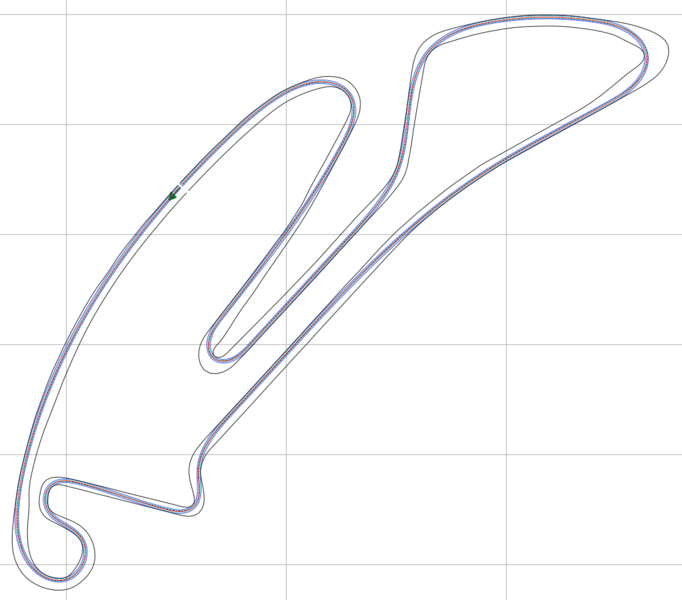Our code is tested with Python 3.5.2
frictionmap: This package contains the functions related to the creation and handling of friction maps along the race track.helper_funcs_glob: This package contains some helper functions used in several other functions when calculating the global race trajectory.inputs: This folder contains the vehicle dynamics information, the reference track csvs and friction maps.opt_mintime_traj: This package contains the functions required to find the time-optimal trajectory including the powertrain components in/powertrain_srcused to calculate power losses, the thermal behavior of the powertrain and to consider the state of charge of the battery.params: This folder contains a parameter file with optimization and vehicle parameters.
Lots of the required functions for trajectory planning are cumulated in our trajectory planning helpers repository. It can be found on https://github.com/TUMFTM/trajectory_planning_helpers. They can be quite useful for other projects as well.
Use the provided requirements.txt in the root directory of this repo, in order to install all required modules.
pip3 install -r /path/to/requirements.txt
The script main_gen_frictionmap.py can be used to create your own friction map for any race track file supplied in the
input folder. The resulting maps are stored in the inputs/frictionmaps folder. These friction maps can be used within
the minimum time optimization. In principle, they can also be considered within the velocity profile calculation of the
minimum curvature planner. However, this is currently not supported from our side.
Step 1:(optional) Adjust the parameter file that can be found in theparamsfolder (required file).Step 2:(optional) Adjust the ggv diagram and ax_max_machines files ininputs/veh_dyn_info(if used).Step 3:(optional) Add your own reference track file ininputs/tracks(required file).Step 4:(optional) Add your own friction map files ininputs/frictionmaps(if used).Step 5:(optional) If you want to consider the powertrain behavior (thermal behavior, power loss, State of Charge), enable the powertrain-option in the params file (/params) and adjust the powertrain parameters as needed (if used).Step 6:(optional) Set the number of race laps in the dictimp_optsinmain_globaltraj.pyand specify a non-regular discretization step length for faster optimization in the parameter file inparams(if used).Step 7:Adjust the parameters in the upper part ofmain_globaltraj.pyand execute it to start the trajectory generation process. The calculated race trajectory is stored inoutputs/traj_race_cl.csv.
IMPORTANT: For further information on the minimum time optimization have a look into the according Readme.md which can be
found in the opt_mintime_traj folder!
We tried to keep a consistant wording for the variable names:
- path -> [x, y] Describes any array containing x,y coordinates of points (i.e. point coordinates).\
- refline -> [x, y] A path that is used as reference line during our calculations.\
- reftrack -> [x, y, w_tr_right, w_tr_left] An array that contains not only the reference line information but also right and left track widths. In our case it contains the race track that is used as a basis for the raceline optimization.
Normal vectors usually point to the right in the direction of driving. Therefore, we get the track boundaries by multiplication as follows: norm_vector * w_tr_right, -norm_vector * w_tr_left.
The output csv contains the global race trajectory. The array is of size [no_points x 7] where no_points depends on stepsize and track length. The seven columns are structured as follows:
s_m: float32, meter. Curvi-linear distance along the raceline.x_m: float32, meter. X-coordinate of raceline point.y_m: float32, meter. Y-coordinate of raceline point.psi_rad: float32, rad. Heading of raceline in current point from -pi to +pi rad. Zero is north (along y-axis).kappa_radpm: float32, rad/meter. Curvature of raceline in current point.vx_mps: float32, meter/second. Target velocity in current point.ax_mps2: float32, meter/second². Target acceleration in current point. We assume this acceleration to be constant from current point until next point.
-
Minimum Curvature Trajectory Planning
Heilmeier, Wischnewski, Hermansdorfer, Betz, Lienkamp, Lohmann
Minimum Curvature Trajectory Planning and Control for an Autonomous Racecar
DOI: 10.1080/00423114.2019.1631455
Contact person: Alexander Heilmeier. -
Time-Optimal Trajectory Planning
Christ, Wischnewski, Heilmeier, Lohmann
Time-Optimal Trajectory Planning for a Race Car Considering Variable Tire-Road Friction Coefficients
DOI: 10.1080/00423114.2019.1704804
Contact person: Fabian Christ. -
Friction Map Generation
Hermansdorfer, Betz, Lienkamp
A Concept for Estimation and Prediction of the Tire-Road Friction Potential for an Autonomous Racecar
DOI: 10.1109/ITSC.2019.8917024
Contact person: Leonhard Hermansdorfer. -
Powertrain Behavior
Herrmann, Passigato, Betz, Lienkamp
Minimum Race-Time Planning-Strategy for an Autonomous Electric Racecar
In Press, https://arxiv.org/abs/2005.07127
Contact person: Thomas Herrmann.
